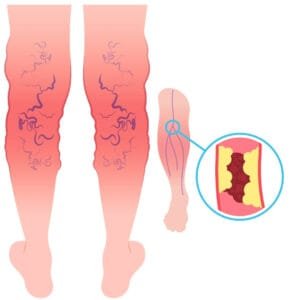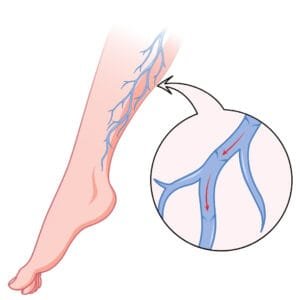Deep Vein Thrombosis: Causes, Symptoms, and Treatment
Deep Vein Thrombosis (DVT) is a serious medical condition where a blood clot forms in the deep veins, typically in the legs. If left untreated, DVT can lead to life-threatening complications, such as a pulmonary embolism. This article explores the causes, symptoms, prevention, and treatment of DVT to help raise awareness about this condition.



What is Deep Vein Thrombosis?
DVT occurs when a blood clot (thrombus) forms in one or more deep veins in the body, most commonly in the lower legs or thighs. These clots can partially or completely block blood flow, leading to swelling, pain, or other symptoms. In severe cases, a piece of the clot may break off and travel to the lungs, causing a pulmonary embolism (PE).
Causes of Deep Vein Thrombosis
DVT is typically caused by one or more of the following:
- Prolonged Immobility: Long periods of sitting or lying down, such as during long flights or hospital stays, slow blood flow in the legs.
- Injury to a Vein: Surgery, trauma, or injury to a vein can trigger clot formation.
- Medical Conditions: Conditions like cancer or inflammatory diseases increase clotting tendencies.
- Genetic Factors: Inherited clotting disorders (e.g., Factor V Leiden mutation) can heighten DVT risk.
- Hormonal Changes: Pregnancy, birth control pills, or hormone replacement therapy may increase clotting risks.
Symptoms of Deep Vein Thrombosis
Some individuals with DVT may not experience noticeable symptoms, but common signs include:
- Leg Swelling: Usually in one leg.
- Pain or Tenderness: Often felt in the calf or thigh, especially when walking or standing.
- Red or Discolored Skin: Around the affected area.
- Warmth: The skin over the clot may feel warmer than usual.
Complications of Deep Vein Thrombosis
Untreated DVT can lead to complications such as:
- Pulmonary Embolism (PE): A potentially fatal condition where a clot travels to the lungs, causing sudden breathlessness, chest pain, and rapid heart rate.
- Post-Thrombotic Syndrome (PTS): Chronic pain, swelling, and ulcers in the affected leg due to long-term damage to the vein.
Risk Factors for Deep Vein Thrombosis
Certain factors increase the risk of developing DVT, including:
- Age: Risk increases with age, especially over 60.
- Obesity: Excess weight puts additional pressure on the veins.
- Smoking: Damages blood vessels and increases clotting risks.
- Surgery or Hospitalization: Especially involving the legs or pelvis.
- Prolonged Travel: Sitting for hours on long flights or car rides.
Diagnosis of Deep Vein Thrombosis
DVT is diagnosed using various methods, including:
- Doppler Ultrasound: The most common test, which uses sound waves to detect clots.
- D-Dimer Test: A blood test that measures clot-dissolving substances.
- Venography: An X-ray of veins after injecting a contrast dye to visualize blockages.
- CT or MRI Scans: Detect large clots, especially if PE is suspected.
Treatment Options for Deep Vein Thrombosis
Medications
- Anticoagulants: Blood thinners like heparin or warfarin prevent new clots and help dissolve existing ones.
- Thrombolytics: Medications like alteplase are used in severe cases to quickly dissolve large clots.
- Compression Stockings: Help reduce swelling and prevent further clots.
Interventional Procedures
- Inferior Vena Cava (IVC) Filter: A device inserted into the vein to catch clots before they reach the lungs.
- Catheter-Directed Thrombolysis: A procedure where medication is delivered directly to the clot through a catheter.
Preventing Deep Vein Thrombosis
Prevention is critical, especially for individuals at risk. Key strategies include:
- Stay Active: Move regularly, especially during long flights or car rides.
- Exercise Regularly: Leg exercises can improve circulation.
- Hydrate: Drink plenty of water to prevent blood thickening.
- Avoid Smoking: Quit smoking to reduce clotting risks.
- Wear Compression Stockings: Especially for high-risk individuals or those recovering from surgery.
FAQs about Deep Vein Thrombosis
1. What causes Deep Vein Thrombosis?
DVT is caused by factors like immobility, vein injury, or conditions that increase blood clotting, such as surgery or smoking.
2. How do you know if you have DVT?
Symptoms include leg swelling, calf pain, warmth, and redness, but some cases may show no symptoms at all.
3. Can DVT resolve on its own?
DVT often requires treatment. Without intervention, it can cause complications like pulmonary embolism.
4. How is DVT treated?
Treatment involves anticoagulants, thrombolytic therapy, or in severe cases, surgical interventions like IVC filters.
5. How can I prevent DVT during travel?
Move your legs regularly, stay hydrated, and consider wearing compression stockings during long flights or drives.
Conclusion
Deep Vein Thrombosis is a serious condition that requires timely diagnosis and treatment to prevent life-threatening complications like pulmonary embolism. Understanding the causes, symptoms, and preventive measures can help reduce the risk and improve outcomes for those affected. If you experience any symptoms of DVT, seek medical attention immediately.
